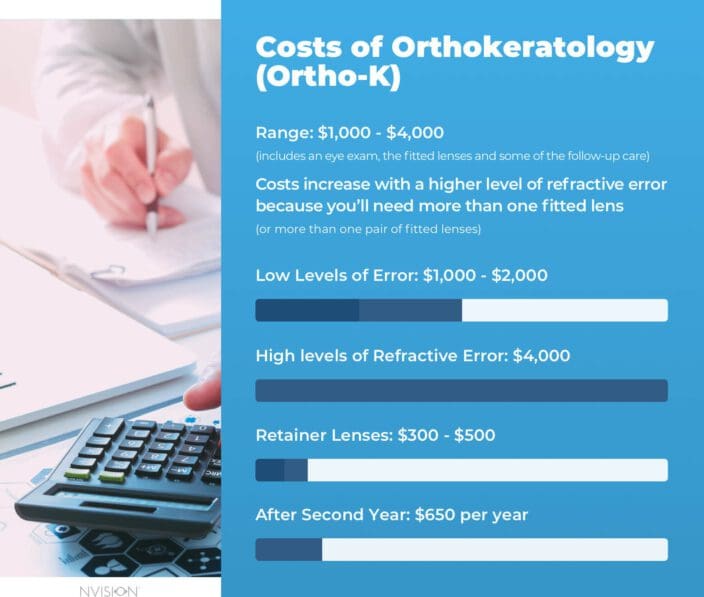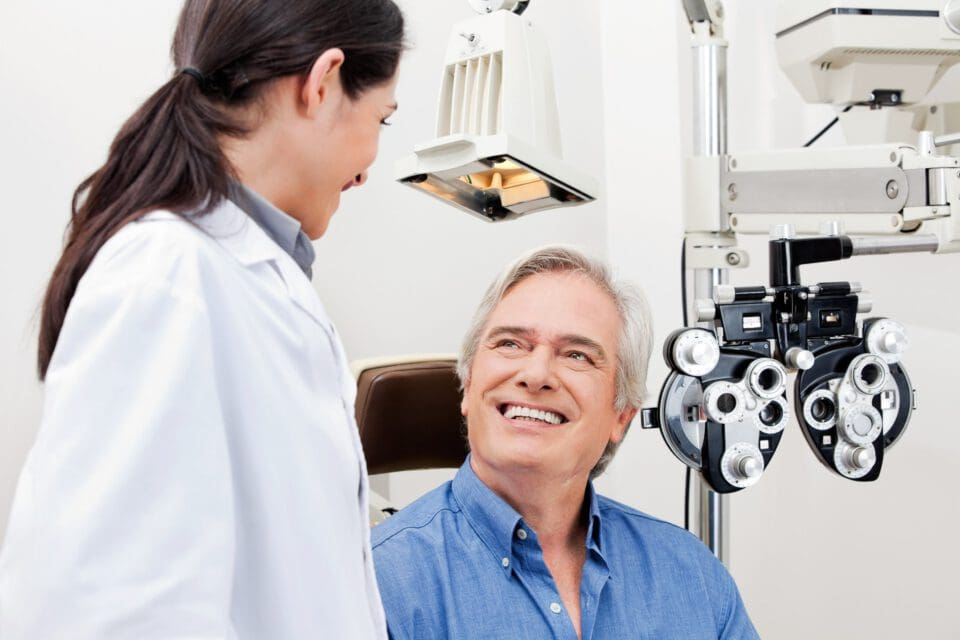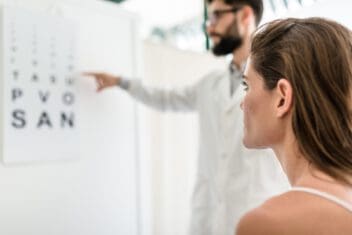Further Reading
Orthokeratology Costs: Prices and Insurance Info in 2025
Home / Orthokeratology Guide /
Last Updated:
If you are interested in orthokeratology as an alternative to improving your visual acuity because you do not want to use glasses, daily contact lenses, or get surgery, you should know it is not a cheap solution. Unlike glasses and contact lenses, orthokeratology is not considered medically necessary. It is elective or cosmetic, so it is not likely that your vision or health insurance will cover the cost.
Table of Contents
While your insurance may not cover it, an associated health savings account may offset some costs. There are also no free options or financial assistance for orthokeratology since it is not deemed medically necessary.
What Are the Costs of Orthokeratology in 2022?

Like other kinds of vision treatments, ortho-K contacts cost vary. The overall costs depend on where you live, your doctor’s experience, whether you choose a doctor with a private practice, your insurance and how many pairs of fitted lenses you desire or need.
As of July 2021, the typical cost of an initial orthokeratology (or Ortho-K), ranges between $1,000 and $4,000. That incorporates an eye exam, the fitted lenses and some of the follow-up care.
Your cost will increase if you have a higher level of refractive error to be corrected. Why? Because it means you’ll need more than one fitted lens (or more than one pair of fitted lenses).
For people with low levels of refractive error, the cost should fall between $1,000 and $2,000 to have contacts fitted to both their eyes. Higher levels of refractive error can increase the cost to $4,000.
The cost of the retainer lenses ranges between $300 and $500, and you will need to go to regular eye exams and replace your hard contact lenses several times to maintain corrected vision.
Costs for the second year and all follow years of Ortho-K use are about $650. This covers the price for:
- A follow-up exam
- Updated corneal topography measurements
- New, updated or replacement lenses
- Removal of current lenses
Additional lenses price out at about $150 per lens ($300 per pair).
Price Fluctuation
You will face higher ortho-K contacts costs if you live in a major city and if you work with an optometrist or ophthalmologist in a private practice. The general cost of living in larger cities, like Chicago, New York, San Francisco or Dallas, is higher than lower density residential areas, rural areas, or suburbs.
This means it costs all medical practitioners more to set up their practices. Private practices incur more financial costs than working in a larger clinic with other practitioners. You may consider going to a vision clinic that offers several specialists in one location, so you have access to a range of vision treatments, including orthokeratology, but pay less overall.
You deserve clear vision. We can help.
With 135+ locations and over 2.5 million procedures performed, our board-certified eye surgeons deliver results you can trust. Your journey to better vision starts here.
Paying a little more for high-quality care is very important. All kinds of doctors, including ophthalmologists, raise their rates for specific areas of expertise. They spend a lot of time training to become experts, ensuring they have access to the best technology.

The Ortho-K process uses a series of gas-permeable hard contact lenses to reshape your cornea over one to four weeks. Then, you wear “retainer” contact lenses at night after your cornea has been molded to temporarily correct your refractive error. The process is a little like having braces, except your eyesight will revert to its original refractive error after a few days if you stop wearing the retainer contact lenses.
Cost of Ortho-K vs. LASIK
It is important to note that the upfront ortho-K contacts cost is around half the cost of LASIK. Cost comparisons show that:
- Orthokeratology ranges from $600 to $1,200 per eye, although complex cases can cost $2,000 or more per eye. This cost does not include any additional costs for replacement lenses, follow-up doctor appointments and lens solution.
- LASIK costs about $1,500 to $2,500 per eye.
Both orthokeratology and LASIK require follow-up visits to a trained ophthalmologist to monitor eye health over the years and to treat any side effects or infections that occur. These treatments are likely to be billed separately, but the cost will be roughly the same. Much of the cost for both will be out of pocket, as both LASIK and orthokeratology are considered cosmetic procedures in most cases.
If you are interested in orthokeratology as an alternative to improving your visual acuity because you do not want to use glasses, daily contact lenses, or get surgery, you should know it is not a cheap solution. Unlike glasses and contact lenses, orthokeratology is not considered medically necessary. It is elective or cosmetic, so it is not likely that your vision or health insurance will cover the cost.
While your insurance may not cover it, an associated health savings account may offset some costs. There are also no free options or financial assistance for orthokeratology since it is not deemed medically necessary.
You deserve clear vision. We can help.
With 135+ locations and over 2.5 million procedures performed, our board-certified eye surgeons deliver results you can trust. Your journey to better vision starts here.
Can Insurance Pay for Orthokeratology?

Your standard vision insurance and your standard health insurance will not cover orthokeratology treatments because they are considered elective procedures. However, associated health savings accounts may help you cover some of the costs of orthokeratology and follow-up eye exams. The following are types of health savings plans you may use:
- Flexible spending account, or FSA
- Medical spending account, or HSA
- Section 125
- Flex 125
- Tax saving plan
- Cafeteria plan
These are employer-sponsored benefits in most cases, but if you self-pay for vision insurance or health insurance, these companies may provide a plan that you can pay into and receive reimbursement from.
As tax season approaches, you can use your tax refund to apply to orthokeratology treatments. You may be able to work with the ophthalmology group on a payment plan, or you could raise the money yourself by putting money aside, setting up a crowdfunding program, or using a credit card and then paying the balance down over time.
Is There Financial Help for Eye Treatments Like Orthokeratology?

The National Eye Institute (NEI) lists options for free eye exams, glasses, and even free contact lenses, or financial help for these basic eye care treatments. However, for elective procedures like orthokeratology, LASIK, or other options, free treatment is not available.
Surgeries and nonsurgical eye maintenance, like cataract or glaucoma treatments, are available for free, low cost, or with government assistance because they are serious conditions that can lead to blindness, which is a public health issue. Managing refractive errors with more extensive treatments beyond glasses or daily wear contact lenses is not considered a public health crisis, so there are not programs to pay for these options.
However, if you undergo an orthokeratology procedure and suffer serious side effects from poor hygiene or from working with an inexperienced ophthalmologist who did not fit your contact lenses properly, you may be eligible for financial assistance to manage care for these issues. The best way to avoid this situation is to research the best possible ophthalmologists in your area who understand the ortho-K process.
You deserve clear vision. We can help.
With 135+ locations and over 2.5 million procedures performed, our board-certified eye surgeons deliver results you can trust. Your journey to better vision starts here.
References
- Orthokeratology (Ortho K) cost and financing. (March 5, 2021). CareCredit.
- Ortho-K Costs. (2021). Vision Source Insight Eyecare.
- Ortho-K. American Optometric Association (AOA).
- What Is Orthokeratology? (September 13, 2018). American Academy of Ophthalmology (AAO).
- Ortho-K and Corneal Refractive Therapy: Overnight Contacts to Correct Myopia. All About Vision.
- Financial Aid for Eye Care. (May 19, 2021). National Eye Institute (NEI), National Institutes of Health (NIH).
This content is for informational purposes only. It may have been reviewed by a licensed physician, but is not intended to serve as a substitute for professional medical advice. Always consult your healthcare provider with any health concerns. For more, read our Privacy Policy and Editorial Policy.